February 11, 2021
Spatial and Compositional Heterogeneities Control Zinc (Zn) Retention Mechanisms in a Simulated Aquifer
Clay lenses, enriched in organic matter, reduced iron, and sulfide, contribute to the extent and variability in zinc retention in a simulated aquifer.

Distribution of zinc (Zn) species within a simulated alluvial aquifer where clay lenses—rich in organic matter, reduced iron, and sulfide —are commonly embedded in the coarse sand.
[Reprinted with permission from Engel, M., et al. “Simulated Aquifer Heterogeneity Leads to Enhanced Attenuation and Multiple Retention Processes of Zinc.” Environmental Science and Technology 55(5), 2939–2948 (2021). DOI: 10.1021/acs.est.0c06750. Copyright 2022 American Chemical Society.]
The Science
Alluvial aquifers are an essential source of groundwater worldwide, particularly for water storage purposes. Fine-grained lenses of clay and organic matter, enriched in iron and sulfur, are abundant within aquifers and support cycling of nutrients, carbon, and toxic metals by providing chemical-reducing conditions in otherwise oxygenated systems. Changes in redox status may have immense influences on the behavior (dissolved concentration, bioavailability, mobility) of heavy metals within the aquifer and resulting groundwater quality. Therefore, researchers investigated the retention of a simulated zinc (Zn) plume in a model alluvial aquifer system containing fine-grained reduced clayey lenses. The fine-grained lenses were specifically responsible for significantly increased Zn retention (23%) resulting in both spatial and compositional differences in the uptake of Zn.
The Impact
Reducing conditions sustained within fine-grained sediment lenses enhanced the extent and breadth of retained Zn species compared to the coarse sediments of a model alluvial aquifer system. Furthermore, Zn loading, and the distribution of Zn species differed between individual lenses, suggesting that unbalanced multiple driving forces vary in intensity along the flow-path. These results emphasize the complex nature of alluvial aquifer systems and behavior of metal contaminants residing within them, which has direct implications to the quality of the groundwater. Thus, the spatial and compositional heterogeneities of alluvial aquifers must be specifically taken into account when maintaining and managing groundwater systems.
Summary
Understanding the biogeochemical conditions in alluvial aquifers experiencing redox heterogeneities is essential to preserve the quality of the groundwater stored within them. The fate of metal contaminants within these complex systems is challenging to predict. Thus, researchers studied the retention pathways of Zn within a model dual-domain (clayey-sandy) alluvial aquifer. The research team used natural coarse aquifer sediments in columns with or without fine-grained lenses from the Wind River−Little Wind River floodplain near Riverton, Wyoming to examine biogeochemical controls on Zn concentrations, retention mechanisms, and transport. Zn preferentially accumulated within the fine-grained lenses, which enhanced Zn uptake by 23%, despite only comprising 5% of the sediment mass in the model aquifer. The research team found that clay minerals and layered double hydroxides dominated Zn retention in the coarse sediments, whereas zinc sulfide prevailed in the fine-grained lenses, emphasizing distinct differences in Zn species between the domains. Zinc was resistant to solid-phase aqueous extraction, but sensitive to acid extraction, which suggests limited but measurable capacity for re-release and transport unless pH decreases considerably. These findings emphasize the importance of considering differences in sediment composition and the size and distribution of heterogeneities in evaluating potential threats of metal contaminants to aquifer groundwater.
Principal Investigator
John Bargar
SLAC National Accelerator Laboratory; Stanford Synchrotron Radiation Lightsource
Bargar@slac.stanford.edu
Co-Principal Investigator
Maya Engel
SLAC National Accelerator Laboratory; Stanford Synchrotron Radiation Lightsource
mayaeng@stanford.edu
Program Manager
Jennifer Arrigo
U.S. Department of Energy, Biological and Environmental Research (SC-33)
Environmental System Science
jennifer.arrigo@science.doe.gov
Funding
The United States-Israel Binational Agricultural Research and Development Fund (BARD; grant no. FI-569-2018) and the Israeli Council for Higher Education provided financial support for Engel through postdoctoral fellowships. The project was conceived and supported by the SLAC Floodplain Hydro-Biogoechemistry Science Focus Area project funded by the U.S. Department of Energy’s (DOE) Biological and Environmental Research (BER) Program, Earth and Environmental Systems Sciences Division (EESS) under contract no. DEAC0276SF00515SBR (SLAC National Accelerator Laboratory). Additional support (for Engel and Fendorf) was provided by Environmental System Science (ESS) Project DE-SC0020205. Use of the Stanford Synchrotron Radiation Lightsource, SLAC National Accelerator Laboratory, is supported by DOE’s Office of Science Basic Energy Sciences (BES) Program (contract no. DE-AC0276SF00515).
References
Engel, M., et al. "Simulated Aquifer Heterogeneity Leads to Enhanced Attenuation and Multiple Retention Processes of Zinc." Environmental Science & Technology 55 (5), 2939–2948 (2021). https://doi.org/10.1021/acs.est.0c06750.

